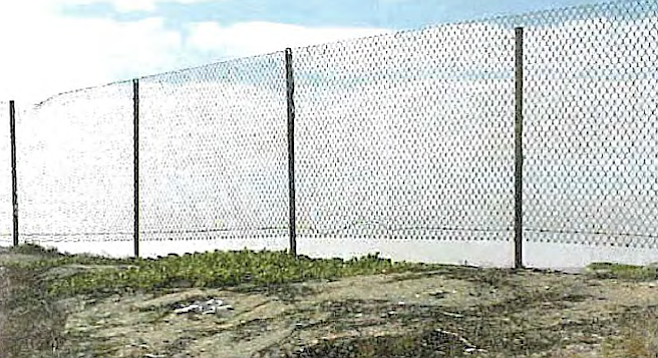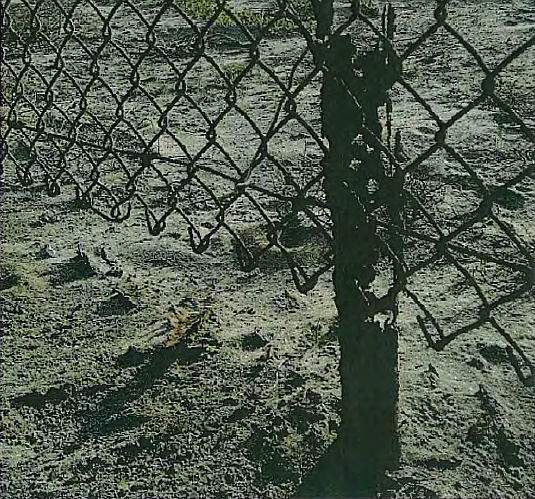 Facebook
Facebook
 X
X
 Instagram
Instagram
 TikTok
TikTok
 Youtube
Youtube

It took a federal agency, a state agency, a state commission, and several citizens' groups — as well as $325,000 — to move forward in replacing 2.1 miles of dilapidated chain-link fence along the Silver Strand. And, when they reached agreement on the size of the holes in the mesh in March after almost two years of negotiations and fundraising, the project was put on hold because of bird-breeding season.

Everyone agrees that the 30-year-old fence along the Silver Strand State Park/Beach is a worn-out, rusty eyesore. But U.S. Fish & Wildlife, the City of Coronado, two community groups, state parks, and the California Coastal Commission all saw the project differently.
"It seemed simple: get some posts, get some wire," says Coronado engineer Ed Walton. "As we got started, there was more and more people with input."
The Silver Strand Beautification Project and the city want to have as little obstruction of the ocean views west of the Strand highway as possible. U.S. Fish & Wildlife and the coastal commission staff want the fence to block predators as much as possible and state parks — grateful for a free fence that will block far more than the one falling down — worked out a balance and a compromise their biologist felt would adequately protect the two endangered birds (the least tern and western snowy plover) in the reserve south of the beach.
And that doesn't touch on the topic of an optional gate.
The existing fence was built in 1984. About 12 years ago, the Silver Strand Beautification Project and the Coronado City Council turned their attention to the fence, which had two-foot gaps between the bottom and the ground in some places, sections with holes, and some that are tilted.
"There are some parts I'm amazed are still vertical," Walton says.
The city talked with state parks and learned there was no money available to fix it, according to city records. The rusty, falling-down fence on state parks land so annoyed the City of Coronado that the city allotted $230,000 to fix the fence and helped raise another $95,000 in grants for a total of $325,000 for the project. The city and state parks hammered out agreements on the height, the poles, and the metal mesh size...and then the fight began.
The southern end of the fence — from just north of the Coronado Cays to the end of the state parks reserve — runs along the nesting zone for the endangered western snowy plover, a small bird that lays its beige eggs unprotected in the sand. To protect the bird and the nests without blocking the views of the beach and ocean, the city and state parks reached a compromise that the holes in the mesh would be 2" by 6" along the southern portion where the birds nest and 6" by 6" along the northern portion. But when the plan was submitted to the coastal commission, U.S. Fish & Wildlife objected, worried that predators — including kestrels, shrikes, and mammals such as cats and raccoons — could pass through the mesh and harm the plovers and their eggs.
Fish & Wildlife insists the mesh at the south end has to be 2" by 2" to protect the birds, according to letters and emails submitted to the coastal commission. The coastal commission staff then submitted its own alternative, which added a foot in height, reduced the mesh to 1.5" by 1.5" and eliminated the emergency gate, in accordance with what U.S. Fish & Wildlife asked for.
"State parks has stated that their staff believes it would be unlikely for predator birds to be able to occupy a 2" by 6" space for the length of time necessary to gain a predatory advantage......" the coastal commission report says. "However, the commission's ecologist, Dr. John Dixon, has reviewed these objections and respectfully disagrees with the applicant."
The coastal commission, after a two-hour hearing on March 9, gave permission to build the fence that's essentially a gift from Coronado to state parks. But breeding season began and runs for six months.
"We'll get back to it in September," Walton said.


It took a federal agency, a state agency, a state commission, and several citizens' groups — as well as $325,000 — to move forward in replacing 2.1 miles of dilapidated chain-link fence along the Silver Strand. And, when they reached agreement on the size of the holes in the mesh in March after almost two years of negotiations and fundraising, the project was put on hold because of bird-breeding season.

Everyone agrees that the 30-year-old fence along the Silver Strand State Park/Beach is a worn-out, rusty eyesore. But U.S. Fish & Wildlife, the City of Coronado, two community groups, state parks, and the California Coastal Commission all saw the project differently.
"It seemed simple: get some posts, get some wire," says Coronado engineer Ed Walton. "As we got started, there was more and more people with input."
The Silver Strand Beautification Project and the city want to have as little obstruction of the ocean views west of the Strand highway as possible. U.S. Fish & Wildlife and the coastal commission staff want the fence to block predators as much as possible and state parks — grateful for a free fence that will block far more than the one falling down — worked out a balance and a compromise their biologist felt would adequately protect the two endangered birds (the least tern and western snowy plover) in the reserve south of the beach.
And that doesn't touch on the topic of an optional gate.
The existing fence was built in 1984. About 12 years ago, the Silver Strand Beautification Project and the Coronado City Council turned their attention to the fence, which had two-foot gaps between the bottom and the ground in some places, sections with holes, and some that are tilted.
"There are some parts I'm amazed are still vertical," Walton says.
The city talked with state parks and learned there was no money available to fix it, according to city records. The rusty, falling-down fence on state parks land so annoyed the City of Coronado that the city allotted $230,000 to fix the fence and helped raise another $95,000 in grants for a total of $325,000 for the project. The city and state parks hammered out agreements on the height, the poles, and the metal mesh size...and then the fight began.
The southern end of the fence — from just north of the Coronado Cays to the end of the state parks reserve — runs along the nesting zone for the endangered western snowy plover, a small bird that lays its beige eggs unprotected in the sand. To protect the bird and the nests without blocking the views of the beach and ocean, the city and state parks reached a compromise that the holes in the mesh would be 2" by 6" along the southern portion where the birds nest and 6" by 6" along the northern portion. But when the plan was submitted to the coastal commission, U.S. Fish & Wildlife objected, worried that predators — including kestrels, shrikes, and mammals such as cats and raccoons — could pass through the mesh and harm the plovers and their eggs.
Fish & Wildlife insists the mesh at the south end has to be 2" by 2" to protect the birds, according to letters and emails submitted to the coastal commission. The coastal commission staff then submitted its own alternative, which added a foot in height, reduced the mesh to 1.5" by 1.5" and eliminated the emergency gate, in accordance with what U.S. Fish & Wildlife asked for.
"State parks has stated that their staff believes it would be unlikely for predator birds to be able to occupy a 2" by 6" space for the length of time necessary to gain a predatory advantage......" the coastal commission report says. "However, the commission's ecologist, Dr. John Dixon, has reviewed these objections and respectfully disagrees with the applicant."
The coastal commission, after a two-hour hearing on March 9, gave permission to build the fence that's essentially a gift from Coronado to state parks. But breeding season began and runs for six months.
"We'll get back to it in September," Walton said.
Comments